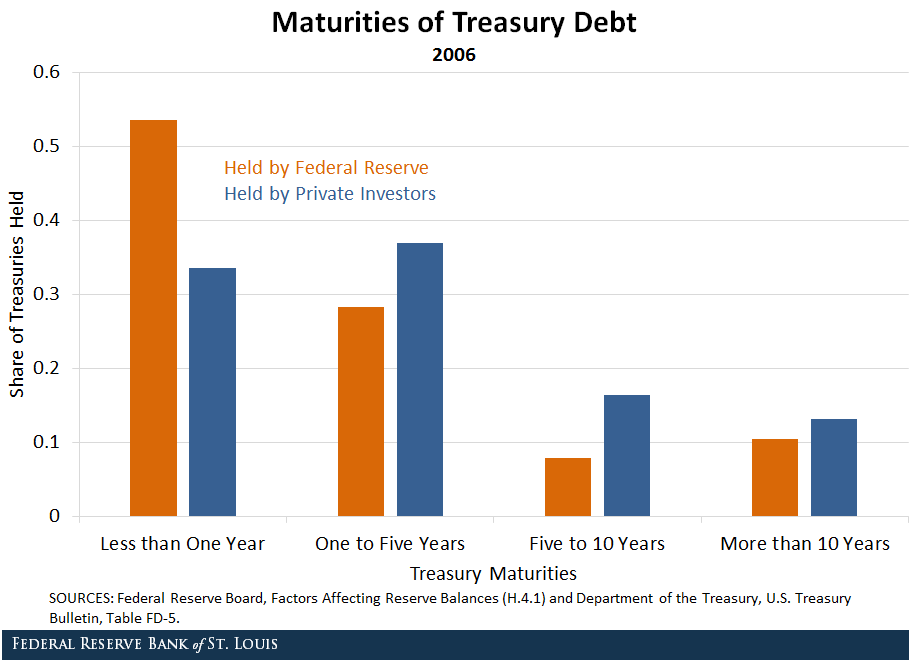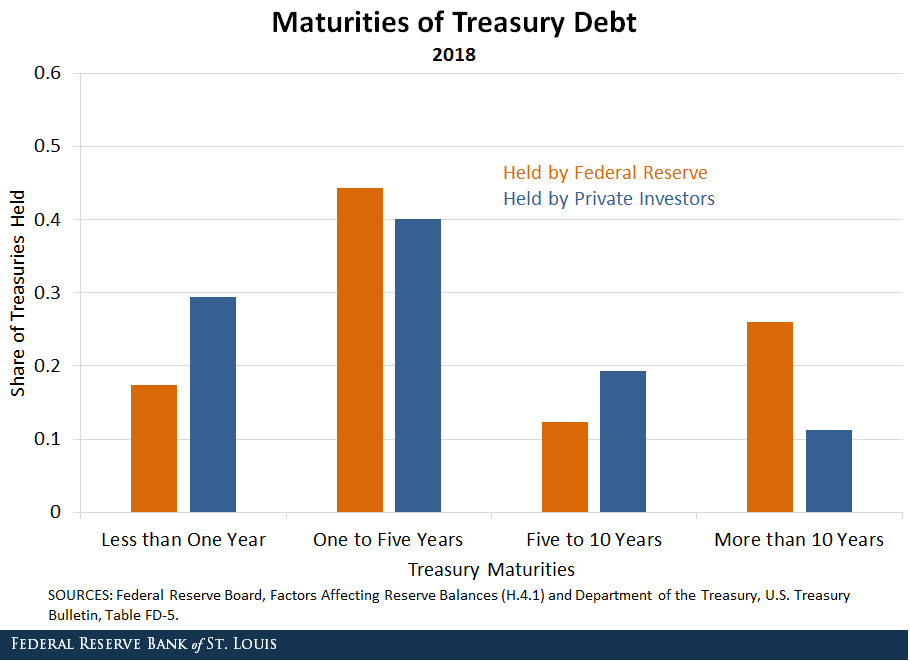The Maturity Structure of Treasuries Held by the Fed

The Federal Reserve’s balance sheet normalization program mostly focuses on the size of the balance sheet. What do we know about the composition of assets on the balance sheet?
Average Maturity of Treasuries
The average maturity of Treasuries on the Fed’s balance sheet increased from about four years before the Great Recession to about eight years today. The figures below show the distribution of the maturity structure of the Treasuries, both held by private investors and the Fed, before and after the Great Recession.


The Treasury kept both the average maturity and the distribution of Treasuries more or less constant before and after the Great Recession. The Fed, however, behaved differently. It had a maturity structure tilted to the short end before the Great Recession. For example, more than 50% of the Treasuries held by the Fed had a maturity of less than one year.
After the Great Recession, however, the maturity structure tilted to the long end, with less than 20% of Treasuries having maturities of less than one year and more than 20% of Treasuries having a maturity above 10 years.
Why Does the Maturity of Treasuries Held by the Fed Matter?
As stated in the normalization principles of June 2017, the Federal Open Market Committee (FOMC) recognized that the economy could again present conditions in which federal funds rate policy is not sufficient and, in those cases, the FOMC would consider using balance sheet policies. Among the tools utilized during the Great Recession, we can distinguish between two types of policies:
- Quantitative easing (QE)
- A maturity extension program (MEP)See, for example, the January 2019 press conference (PDF) by Fed Chairman Jerome Powell.
On one hand, QE consisted of buying assets, which reduced long-term rates and increased the Fed’s balance sheet. On the other hand, MEP was a swap of short-term Treasuries for long-term Treasuries, increasing the average maturity of the assets on the balance sheet and reducing long-term rates without affecting the size of the balance sheet. Therefore, the main difference between these two policies is that QE increased the size of the balance sheet while MEP did not.
One requirement to implement an MEP is to have a buffer of short-term Treasuries in the balance sheet to be able to implement the swap between short-term and long-term Treasuries. In 2011, when the MEP was implemented, the Fed had a buffer of short-term Treasuries. The first figure above showed that the Fed had a large amount of short-term Treasuries before the Great Recession which allowed it to implement the MEP during 2011.
However, the second figure shows that the Fed does not currently have a large enough buffer of short-term Treasuries. Perhaps, the Fed might want to consider a preventive measure and implement a maturity contraction program (MCP)—namely, swap long-term Treasuries for short-term Treasuries to reduce the average maturity of the assets on the balance sheet and be prepared in case an MEP is needed in the future.
According to some analysts,See, for example, Hamilton, James D.; and Wu, Jing Cynthia. “The Effectiveness of Alternative Monetary Policy Tools in a Zero Lower Bound Environment,” Journal of Money, Credit and Banking, February 2012, Vol. 44, Issue s1, pp. 3-46. implementing an MCP in the current economy would likely have less impact on the yield curve, while an MEP can be effective if the economy is under financial stress. The reasons for the state-dependent effects of balance sheet policies is that in normal times, the supply effects (either QE-QT or an MEP-MCP) are arbitraged away by market participants. In periods of financial stress, however, arbitrageurs are reluctant to fully absorb the sales or purchases by the Fed, which can help to push down long-term interest rates.Think, for example, in a time-varying preferred habitat model as in Ray, Walker. “Monetary Policy and the Limits to Arbitrage: Insights from a New Keynesian Preferred Habitat Model (PDF) ,” unpublished manuscript, January 2019.
Notes and References
1 See, for example, the January 2019 press conference (PDF) by Fed Chairman Jerome Powell.
2 See, for example, Hamilton, James D.; and Wu, Jing Cynthia. “The Effectiveness of Alternative Monetary Policy Tools in a Zero Lower Bound Environment,” Journal of Money, Credit and Banking, February 2012, Vol. 44, Issue s1, pp. 3-46.
3 Think, for example, in a time-varying preferred habitat model as in Ray, Walker. “Monetary Policy and the Limits to Arbitrage: Insights from a New Keynesian Preferred Habitat Model (PDF),” unpublished manuscript, January 2019.
Additional Resources
- On the Economy: When Quantitative Tightening Is Not Quantitative Tightening
- On the Economy: Is the U.S. Economic Expansion Due to End?
- On the Economy: Why the Fed Should Create a Standing Repo Facility
Citation
Julian Kozlowski, ldquoThe Maturity Structure of Treasuries Held by the Fed,rdquo St. Louis Fed On the Economy, May 13, 2019.
This blog offers commentary, analysis and data from our economists and experts. Views expressed are not necessarily those of the St. Louis Fed or Federal Reserve System.
Email Us
All other blog-related questions


